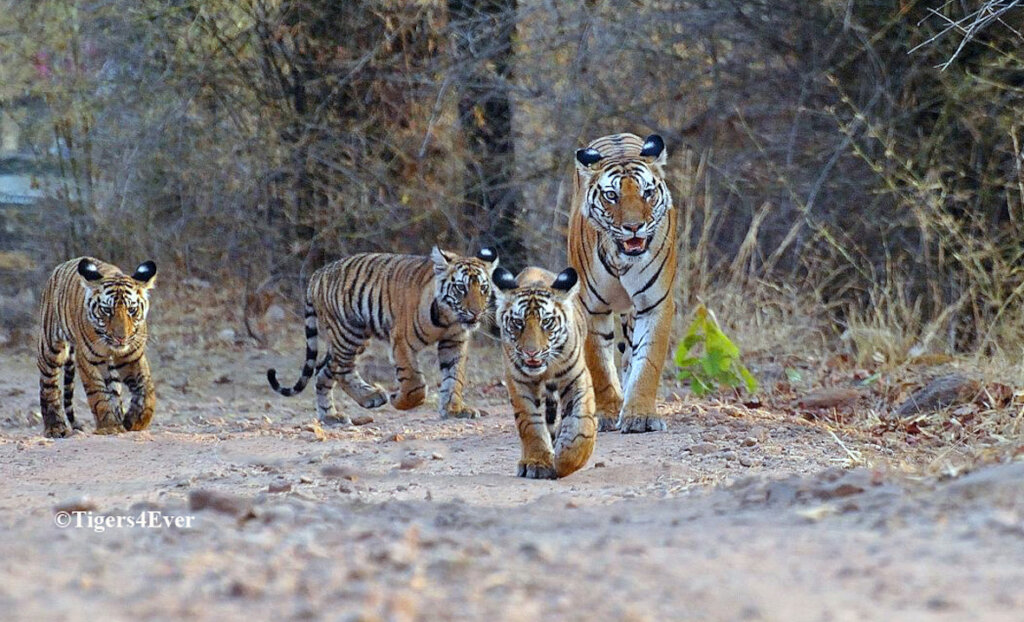By Dr Corinne Taylor-Smith | Project Leader
We were absolutely blown away by your incredible support from Giving Tuesday (30 November 2021) until the end of 2021. Your generosity will help us to make increased patrolling the new standard in 2022, which we think it is a fitting tribute for the Year of the Tiger. Thank you so very much for making this possible.
In India, which is home to two thirds of the world’s last remaining wild tigers, statistics from the NTCA (National Tiger Conservation Authority – formerly Project Tiger) showed that wild tiger deaths in India alone had risen to the highest level for ten years. Poaching gangs across India have maximised the chance during the COVID lockdowns to increase their illicit activities. Even with our patrols tripled, poachers struck in Bandhavgarh killing the Banvai female and dumping her carcass in an open well at the end of the monsoon. It was soul destroying to know that despite our significant efforts to comb the forest for snares and traps so wild tigers can walk freely, one such snare had gone under the radar and claimed the life of a precious wild tiger. That is why we decided at our last Board of Trustees meeting just a few days ago that increased patrolling will have to be the new standard if we are to prevent this happening again. A decision we couldn’t have taken without your generosity, so thank you again.
Tiger Census
Over the last few months of 2021, the all India Tiger census was being carried out across the 51 protected areas for wild tigers. Known corridors for tiger movement, other sanctuaries and forests where wild tigers are known to roam were also combed by foot patrollers looking for wild tigers and evidence of their territories. Camera traps were set along geographical transect lines to monitor not just how many different tigers but to capture their images for future identification too. Scat and hair samples, from trees used as tiger scratch posts, are also collected as part of the identification process too. It is important to ensure that the same tiger isn’t counted multiple times as wild tigers have very large territories with male wild tigers known to patrol and scent mark around 7300 km (4536 miles) around their territory in a year! Dependent on the availability of prey and water, wild tiger territories can vary from 20 sq. km (7.7 sq. miles) in size to 400 sq. km (154.5 sq. miles), which covers a lot of camera traps and trees!
The hard work continues as the collected data seeks to eliminate duplicates and confirm the current numbers of wild tigers inside and outside the protected areas. We are hopeful, that despite an increase in Tiger-Tiger conflict and human-tiger conflict during the pandemic, that the tiger census will confirm at least the same number of wild tigers in Bandhavgarh as in the 2018 Tiger census. You may wonder why we don’t think that the number will increase massively again as it did last time. With 42 cubs born during the pandemic and improved cub mortality rates since the introduction of our Anti-Poaching patrols in July 2015, it’s not an unreasonable assumption, but Bandhavgarh is wild tiger territory not a sanctuary or zoo, so the tigers are free to come and go as they choose. Young adult male tigers are usually kicked out of their mother and father’s territories as they reach 3 years old, whilst some hang around on the fringes of their former home with siblings or even alone, others make the bold decision to find a new territory to call home. For some young males, this nomadic behaviour may continue for 2 or more years dependent on many factors including how many females are around, are there other stronger males to resist their challenge and is there enough prey to eat.
The Tiger Census also counts the numbers of prey animals in each transect to help determine the carrying capacity of the area. At the last Tiger Census in 2018, the number of wild tigers in Bandhavgarh was significantly higher than the predicted carrying capacity of the 2014 census. We have worked really hard since 2018 to increase the number of permanent wildlife waterholes in Bandhavgarh so that prey numbers will increase, wild tigers will need smaller territories and conflict situations can be avoided. As I write this project report, work is underway to provide year-round permanent water resources at two more locations bringing the total number of Tigers4Ever waterholes to eleven and supporting more than 48 wild tigers. We also hope to create at least one more waterhole for wild tigers, before the drought season takes hold, subject to raising another £1000 (US$1400) to fund the work. https://www.globalgiving.org/projects/water-for-bandhavgarhs-tigers/
Year of the Tiger
You have probably seen a lot in the news recently about 2022 being the Lunar Year of the Tiger. You may also recall in the last Year of the Tiger in 2010, the thirteen tiger nations pledged to double their wild tiger numbers by 2022. Back in 2010, the global wild tiger population was estimated at 3200 and by 2018 this had increased to 3900, quite some way short of the proposed 6400 which had been pledged in 2010. In 2010, India had more than 1411 wild tigers (2008 census results) so when it reported that this had increased to 2967 wild tigers in 2018 there was a sense of achievement against the 2022 target. What it is important to know is that the 2014 census reported 1785 wild tigers in India and that prior to 2010 cubs and sub-adult tigers were not counted in the census data.
The more recent census information has counted wild tigers over 12 months old in the census data, thus the results for 2022 (from the 2021 count) will be the ones to provide the best measure. One thing which we can be certain of is that in 2010 the tiger census in Bandhavgarh recorded just 37 wild tigers, and since we launched our Anti-Poaching Patrols in July 2015, wild tiger deaths due poaching and retaliatory poisoning have reduced by 98%. The combination of our efforts and improvement cub mortality saw wild tiger numbers reach an estimated 126 in Bandhavgarh in 2018, which is three times the number back in 2010, but also reflects different counting methods. So we honestly believe that our work has ensured that the number of wild tigers in Bandhavgarh has doubled (and a bit more) since the last Year of the Tiger in 2010, the challenge for us now is making sure these increases can be sustained and that future generations have suitable safe habitat and enough prey. For this reason we will be focussing our efforts on providing as many new permanent wildlife waterholes as we can throughout 2022 (https://www.globalgiving.org/projects/water-for-bandhavgarhs-tigers/) and looking to start our forest restoration initiative with a new project for tree planting too. This doesn’t mean that we won’t be prioritising keeping wild tigers safe, quite the opposite in fact as our waterhole and tree planting projects seek to reduce the number of wild tigers killed in territorial conflicts.
The Next Tiger Challenge
Your fantastic support at the end of 2021 means that our concerns of the last two years that we wouldn’t have enough funds to keep the increased patrolling going for as long as is necessary, have reduced. We are not taking the situation for granted though, keeping the increased patrolling going has tripled our monthly patrolling costs, such that we now need to raise more than £1800 (US$2520) each month to maintain the status quo. For this reason we have decided to centralise our fundraising efforts on our original Anti-Poaching Patrols project https://www.globalgiving.org/projects/saving-bandhavgarhs-wild-tigers/ and we’re asking those of you who are kind enough to donate to this project each month to consider setting up a new monthly donation to our main project at: https://www.globalgiving.org/projects/saving-bandhavgarhs-wild-tigers/?show=recurring where you will be able to continue your fantastic support. As an added bonus, when you set up a new monthly donation GlobalGiving will add a 100% bonus in matched funds if you keep your regular support in place for at least four months. This is great because your donation of £20 (US$28) per month will be worth £100 (US$140) to our conservation efforts for wild tigers at the end of month 4.
We think that our current: https://www.globalgiving.org/projects/protect-bandhavgarhs-tigers-from-poachers/ is likely to be fully funded by Easter this year, which is great because we’ll be able to plan our monsoon patrolling early. On a sad note, it means that the next project update report you receive for this project may well be the last. On a positive note, it means that we will be keeping wild tigers safe from poachers’ snares and would be poisoners with the highest level of protection possible over the next two months and beyond.
Should you wish to help us achieve our goal sooner that would be wonderful of course. As you already know, our patrollers cover vast amounts of tiger territory on their daily patrols (on average around 125 km (78 miles) per day) in an area which is roughly the size of Wales (UK) or two thirds the size of the State of New Jersey (USA), so we can always make good use of any donations we receive to benefit the wild tigers (https://goto.gg/34704).
You are Making the Difference
Right now, thanks to your tremendous support we’re able to protect wild tigers in an extra 1000 km (624 miles) every month compared to our previous standard patrolling (back in June 2020). This additional patrolling allows us more time to search for snares; traps and signs of would be poisoners around forest areas where human encroachment is rife; and around the periphery of villages where crop raiding and livestock killing is rife. Increased patrolling also helps us to curb the dangerous encroachment into wild tigers’ territories, which continues to be a big problem, and allows us to provide safety advice for those trying to protect their crops and livestock from wandering elephants and tigers respectively.
With 42 new tiger cubs born since the start of the pandemic, we have many more wild tigers to keep safe now. So we still need your help. Your gift today, however large or small will always make a huge difference to the survival prospects of Bandhavgarh’s wild tigers:
Without our help, we know that more wild tigers will die; and more humans will be mauled or killed due to encroachment or human-tiger conflict. Sadly, with every human life lost comes another threat to the wild tiger’s survival in the form of retaliation; thus we must protect both if we are to ensure that wild tigers can have a wild future.
Please don’t hesitate if you can help, your donation can be the difference between life and death for a wild tiger, as it helps to increase our patrolling when and where it is most needed. Every tiger and every tiger cub counts. Thank you for making our fight against poachers, the changing climate and human-animal conflict possible. (https://goto.gg/34704).
Links:
Project reports on GlobalGiving are posted directly to globalgiving.org by Project Leaders as they are completed, generally every 3-4 months. To protect the integrity of these documents, GlobalGiving does not alter them; therefore you may find some language or formatting issues.
If you donate to this project or have donated to this project, you can receive an email when this project posts a report. You can also subscribe for reports without donating.
Support this important cause by creating a personalized fundraising page.
Start a Fundraiser
